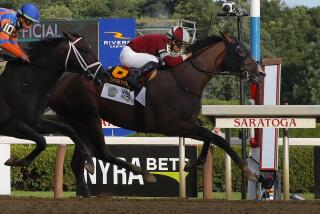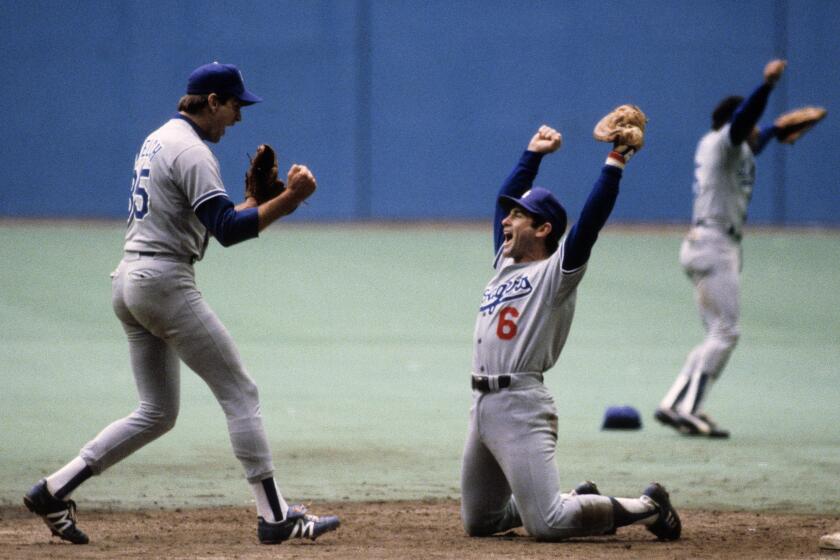Maryland on Right Track as Thoroughbred Racing’s Stock Rises
For more than a decade, thoroughbred racing has suffered a steady and woeful decline in Maryland. The state’s tracks, with their poor physical facilities and complacent managements, couldn’t attract new fans and were alienating their old ones.
In 1975, when year-round racing was first conducted in the state, the average daily attendance at the mile tracks was 9,058. Year by year, the crowds grew thinner until, in 1984, the average attendance figure had fallen to a pitiful 7,201. Maryland racing was on the brink of minor league status--or oblivion.
But when Laurel Race Course starts an 81-day season Sunday afternoon, it will open its gates amid an atmosphere of almost unprecedented optimism and enthusiasm. Pimlico ended a successful meeting Saturday, and Laurel President Frank DeFrancis expects an excellent season at his track. The average attendance at the state’s mile tracks for 1985 should be more than 7,600--evidence that the tide is turning. “We are building the base for a total resurgence of racing in Maryland,” DeFrancis said.
This resurgence has happened for two reasons: the purchase of Laurel by DeFrancis, and the passage of an omnibus racing bill by the Maryland legislature.
When DeFrancis bought Laurel last winter, he was filled with enthusiasm and confidence in the future of Maryland racing. After his dramatic transformation of decrepit Freestate Raceway, he knew he could revive Laurel’s fortunes, too. His optimism was contagious, and even Chick Lang, his friendly rival at Pimlico, gave him credit for it. “Two or three years ago, we were on a dead-end street,” Lang said. “There’s no question that Frank DeFrancis’ changes at Laurel got a lot of attention and awoke a sleeping industry.”
With DeFrancis as a catalyst, the various segments of the industry--breeders, horsemen, track owners--finally ended their feuding long enough to work for the passage of a racing bill in Annapolis. Enacted July 1, its effects already are being felt.
The closing of Bowie and the shortening of Timonium’s meeting to 10 days finally have given the state year-round racing at decent physical plants. Shortening the Timonium season also has stopped the annual summer exodus of top stables and jockeys to New Jersey. Better racing has helped attract bigger crowds.
Under the racing bill, the state relinquished much of its tax revenue from parimutuel wagering so that the money could be plowed back into the sport. The investment already is paying off.
At Pimlico, Lang said, “We have spent more money in advertising, marketing and promotion than in any of my 25 years here. We’ve admitted students free on Saturdays with their college IDs. We’ve had entertainment in the infield on eight Saturdays. We had a giveaway of ‘Pimlico classic shirts.’ Financially, it’s been costly but we’re seeing a lot of new faces and I think we’re heading in the right direction.”
Laurel has put its money into plant improvements, most notably its futuristic Sports Palace--which won’t be ready to open for a few more days. Among the new features that opening-day patrons will see Sunday are spiffy front-row boxes. (“They’ve got carpeting, multi-channel TV and luxurious seats,” DeFrancis said.)
The passage of the racing bill created a beneficial side effect for the industry. Track managements, horsemen and breeders learned that they could work together without attempting to slit each other’s throats, and that their cooperation could pay off. “There’s a definite working closeness that hasn’t been here before,” DeFrancis said. Because of it, these disparate groups were able to join together again and create the Maryland Million, a one-day extravaganza of nine rich races for offspring of Maryland stallions, which should provide yet another stimulus for the sport.
The changes in Maryland racing are not only boosting the tracks’ attendance and handle, but they are having an important intangible effect, too. Both Lang and DeFrancis talk about the upbeat spirit and atmosphere surrounding the sport, and that’s not just management propaganda. Racing fans can feel it.
I have been going to Maryland race tracks for 19 years and writing about them for 15 and, during that entire period, it has been difficult to feel or say anything positive about the sport here. Every horseplayer I know could recite a litany of complaints. Many of them, even the hard-core players, became so disgruntled that they would go to the Maryland tracks with less and less frequency. Some defected altogether.
Yet over the last few months I have sensed a definite change in the attitude of local racing fans. Laurel’s Sports Palace has prompted a great deal of discussion and positive comment. So has the Maryland Million. The other night, I was sitting at a table full of action guys in a local bar when somebody asked, “Is anybody here not going to Laurel on Sunday?” It’s been a long time since a Maryland horseplayer would phrase the question that way.
The resurgence of Maryland racing means a lot more than greater revenue for Laurel, Bowie and the other components of the thoroughbred industry. It is bringing back to fans in Maryland the sheer pleasure of going to the races.
More to Read
Go beyond the scoreboard
Get the latest on L.A.'s teams in the daily Sports Report newsletter.
You may occasionally receive promotional content from the Los Angeles Times.










